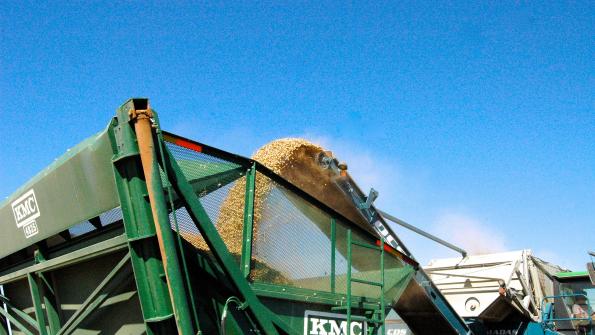November 9, 2016

Low peanut prices may be a boon for oil and other food processors that benefit from favorable profit margins, but growers like Michael Newhouse of Clarendon, Texas, need a stronger market to have the crop pencil out a farm profit.
In recent years, a major world peanut surplus has put peanuts in line with other commodities faced with depressed markets. For most farmers, wheat, corn, sorghum, cotton and other major cash crops also don’t boost the bottom line. Fortunately, peanut farmers could see some relief after huge export sales to China relieved some of the supply pressure.
That’s good news for Newhouse and others across the Southwest. “I love growing peanuts,” Newhouse said, while hauling a load of runners to a Golden Peanuts buying point outside Clarendon during harvest in late October. “But our contracts haven’t been very attractive. Runners could only be contracted for $400 per ton. Spanish brought about $450. We hope to see better prices next year with the reduction of some of the surplus.”
Shelly Nutt, executive director of the Texas Peanut Producers Board, said that after exhausting the cheap peanut supply from Senegal, and because of poor quality crops in Argentina, export activity into China was significant. “Basically, we're now sitting with even stocks. There's no surplus, but really we're not too short either,” she said. “In Texas, we're seeing some late season contracts, especially on peanuts under irrigation that weren't contracted in the spring.”
YIELD ADVANTAGE
Higher yields help offset some of the poor prices. And Newhouse accomplishes that by sticking to a solid rotation to get the most out of the soil and his center pivot irrigation program. He typically plants winter wheat, and then follows it the next year with cotton. Peanuts follow cotton, although he’s now working more milo into the mix.
“Due to an increase in glyphosate resistant weeds, I’ve backed off some on cotton acres and gone with more sorghum,” Newhouse said. “Milo is on a lot of our half-circles. We’ve had to spray a lot for sugarcane aphid, but we still like how the sorghum ground helps handle some of the resistant pigweed issues when we come back with peanuts.”
[CHARTBEAT:3]
While some West Texas growers faced cool, wet conditions at planting time, Newhouse got his planter in the field on time during the first week of May. He dodged early-season disease problems thanks to a good seed treatment plan. “We also have a strict fungicide program in mid-summer,” he says.
“We try to get fields treated by about July 15. We’ve used Headline in the past, but went with Elatus this year because Headline has been in low supply. The new fungicide worked well and the cost was half as much. Guys who didn’t get their fungicide out had some leaf spot and pod rot problems. They had to dig about two weeks earlier.”
DISEASE ISSUES
Chuck Wilbur, an independent crop consultant in Wellington, says Bacterial blight was an issue for some southeastern Panhandle and southwestern Oklahoma farmers. “But overall, we saw mild disease pressure,” he said. “There were no runaway issues with leaf spot or pod rot.”
He adds that early peanuts graded in the high 60s and low 70s. “Yields for many are in the 4,000 to 5,000 pounds per acre, with some at more than 5, 000,” Wilbur says.
Nutt says in South Texas, Spanish yields are down this year, “but runners look really good. Harvest conditions are perfect. In the Panhandle and West Texas, September rains had many farmers worried. The rains brought diseases into play that we've never experienced before.
“Farmers who didn't stay on top of the disease pressure with fungicide applications have or will lose yield. Some fields are scattered with black plants, especially in low lying areas where water sat.”
For the latest on southwest agriculture, please check out Southwest Farm Press Daily and receive the latest news right to your inbox.
Newhouse saw yields in the 4,800-pound range for fields with less irrigation water. Others were making 5,200 to 5,500 pounds.
GOOD MENTORS
At only 31, he admits he still has a lot to learn about making the best crops possible. He’s had good tutorage. His father, Mike, still farms around Clarendon and has a separate operation. He often offers his advice.
“Another mentor for me and other younger farmers was Bob White,” Newhouse says. “He recommended wheat in rotations, a program that others didn’t agree on. But a wheat rotation has worked for me. We lost Bob when he passed in October. He was a good friend and a great farmer and voice for the peanut industry.”
Nutt said White and other leaders in the Texas peanut industry helped in their efforts to promote the peanut checkoff to help fund research. “We've spent over 10 years focusing on growing the reputation of high quality Texas peanuts,��” she says. “We have something good and unique to offer as peanut farmers – and that's a peanut supply grown under irrigation – aflatoxin free.
“I'd like to encourage farmers to continue to manage their peanut crop with the highest level of diligence to maintain the reputation we've worked so hard to build,” she says.
About the Author(s)
You May Also Like




